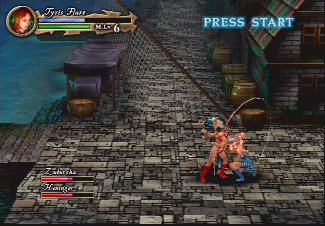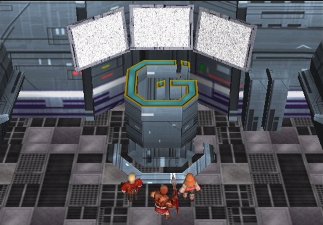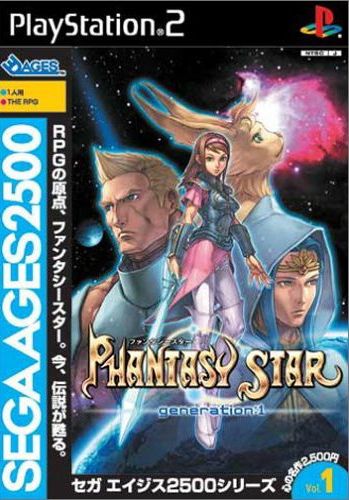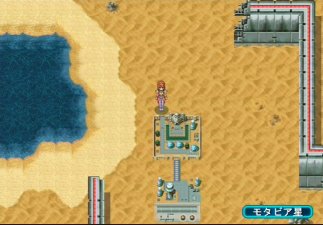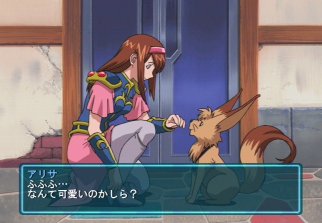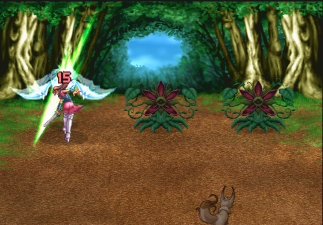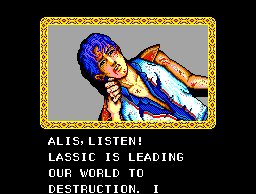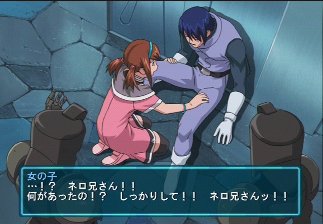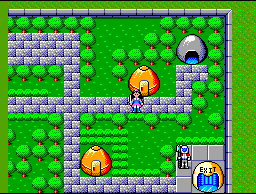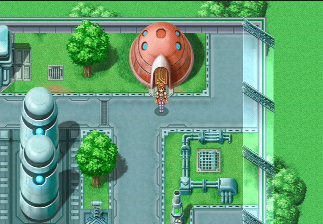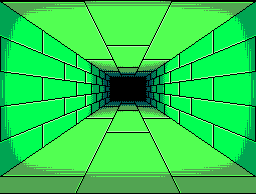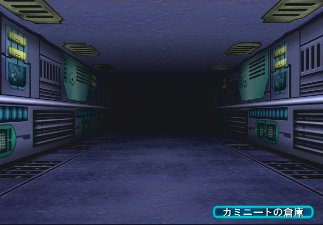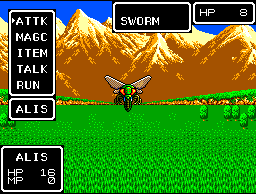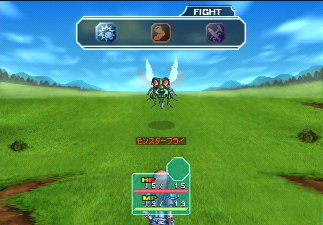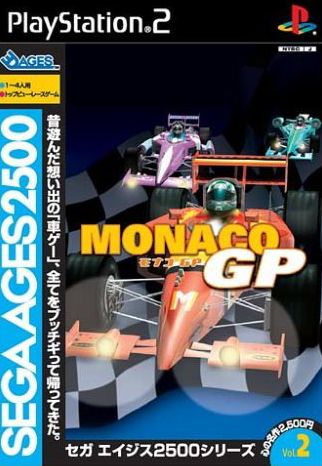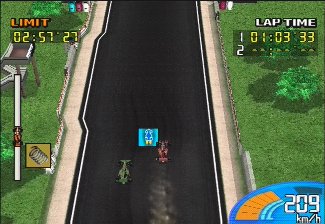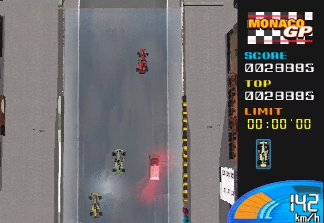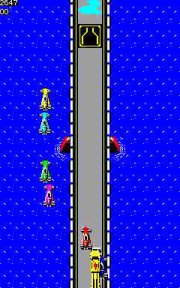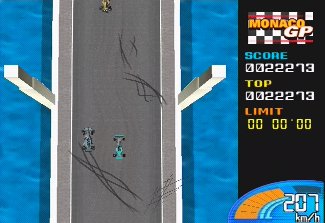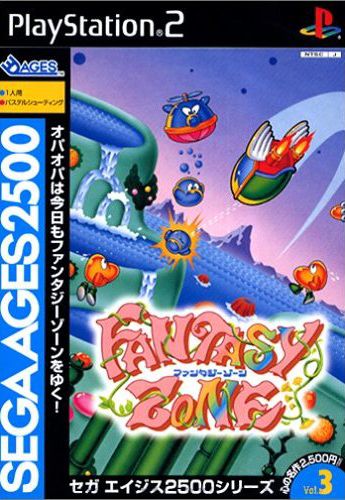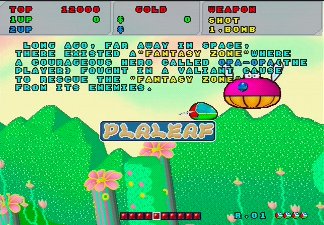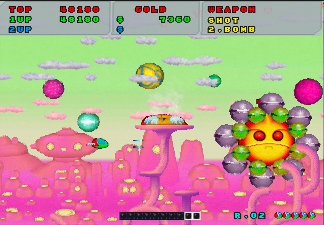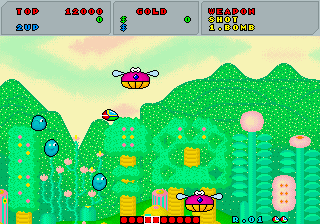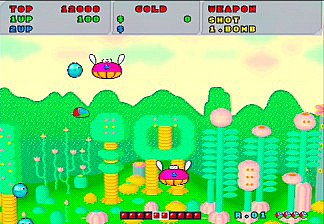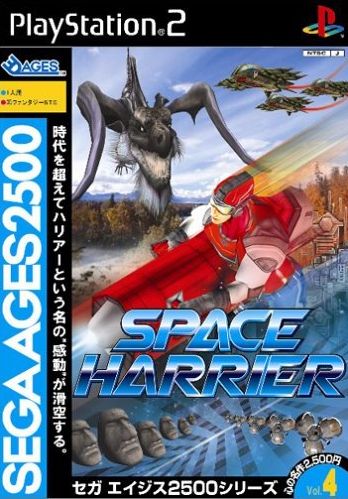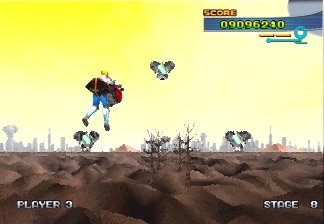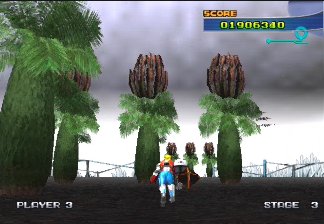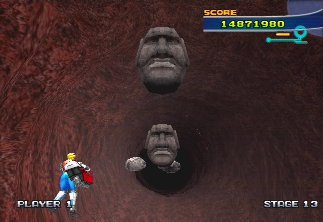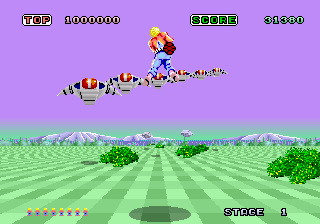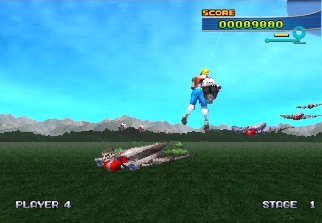
|
<<< Prior Page |
|
Page 1: |
Page 2: |
Page 3: |
Page 4: |
|
|
Page 5: |
Page 6: |
Page 7: |
Page 8: |
Like most early video game companies, Sega began in the arcade business, which they used as strong selling point for their home consoles. "Get the arcade experience - at home!" they bragged, even though this wasn't entirely true. The 8-bit Sega Master System had a huge number of home versions, but all of them were heavily compromised due to the inferior hardware. The 16-bit Genesis was vastly superior, but even then, couldn't quite duplicate the experience, especially with 3D games like Space Harrier and After Burner. It wasn't until the Saturn that home consoles could offer arcade perfect experiences - at least, for games that were, in 1995, nearly ten years old. And so Sega began the Sega Ages line, which included faithful renditions of Sega arcade classics, ranging from their obscure early 80s to more popular favorites like Space Harrier, OutRun, Fantasy Zone and After Burner.
With the release of the PlayStation 2, the execs at Sega had a seemingly bright idea. Their rationale was that most people didn't like to play retro games because they looked old. They figured that if they would rerelease these old games again, but instead offer modern 3D graphics, the general populace would gobble it up. Furthermore, they observed the popularity of D3's Simple Series of cheaply made budget titles, and teamed up with the company to create a brand new label: 3D Ages (or "Sega D3" spelled backwards, which must've seemed pretty clever at the time.) Each Sega Ages game would be released separately in Japan for the low price of 2500 yen (roughly $22 at the time). Most were farmed out to third rate development houses like Sims, who'd been in bed with Sega for a long time and previously worked to port many Sega arcade games to home platforms.
In theory, this wasn't really a bad idea, but it didn't really turn out so well in practice. The big problem had do with the "3D is superior!" attitude held by a lot of people. It didn't matter that the old arcade games had some damn fine 2D artwork, all you needed to you was shove some polygons in there and you'd have a brand, spanking new modern games, right? Naturally, this didn't quite translate into success. Not only were the remakes usually ugly, but the gameplay was rarely updated in any meaningful way. Gamers in the PS2 generation had expected longer and more complicated games, and five minute long bursts of fun no longer cut it, even if it was technologically superior (sort of). Furthermore, the audience that actually did like these retro games were appalled that they were being asked to spend more money on games that actually looked worse than before.
Luckily, after the first few batches, Sega wised up and put some more effort into the Sega Ages line. The title was a vague misnomer, since not all of their titles were 3D - remakes of the Phantasy Star RPGs were 2D, as well as scattered titles like Puyo Puyo 2. As the years went on, started releasing ports of arcade classics like Virtua Fighter 2 and Fighting Vipers, which got decent-but-not-arcade-perfect ports on the Saturn. Pretty soon, they ditched D3 and started handling the line themselves, ensuring higher quality releases. They polished Saturn titles like Dragon Force and Panzer Dragoon, and released themed retro compilations, including tributes to classic series like Space Harrier and Monster World, and filling them to the brim with supplemental materials. Many of these were developed by M2, the same company contracted to take care of the Mega Drive portion of the Wii Virtual Console. In a period of a couple years, the name Sega Ages had evolved from a total embarrassment into a high quality line of software, offering some of the best retro compilations available.
Unfortunately, most outside of Japan might not get that impression. SCEA would never let Sega publish the games individually like they had in Japan, and so they licensed the release to Conspiracy Entertainment, who would release a series of multi game compilation. The only one publicly announced was the Phantasy Star Collection, which would have included translated versions of the Phantasy Star I, II, and IV remakes. Unfortunately, Sega fell behind schedule and had delayed the release of Phantasy Star II, and completely cancelled Phantasy Star IV. (Other announced titles that were later cancelled included Streets of Rage and Alex Kidd.)
Since Conspiracy wasn't doing anything else with the Sega Ages line, Sega reclaimed the license and released their own compilation in the West, dubbed the Sega Classics Collection. This included nine of the Sega Ages games, including Monaco GP, Fantasy Zone, Space Harrier, Golden Axe, Bonanza Bros / Tant-R, Columns, Virtua Racing, OutRun, and Alien Syndrome. (Alien Syndrome was left off the European release.) It was released at $20, an incredible value since these releases totalled at least over $150 in Japan. Unfortunately, most video game press didn't see it that way, and lambasted the release for the poor 3D graphics. The collection apparently didn't sell very well, thus sealing the fate for any future releases. So the only way to experience a majority of the Sega Ages releases is to go for the Japanese versions.
There is a "limited edition" of Phantasy Star: Generation 1 you which just includes an outer cardboard box that carries a small blue binder. Each Sega Ages game was meant to include a little tabbed file that contained a short bio of the main developers, along with the original cover artwork and a bit of background. The idea was, if you bought all of the Sega Ages games, eventually your binder would be full. They stopped around volume 20 when Sega took over, so Fighting Vipers was the last game to include these. Instead, they expanded the instruction manuals and put the miscellaneous information in there. as of current, the series has stopped at Volume 33. Their official site for the whole series is here.
Sega Ages 2500 Vol. 1: Phantasy Star generation 1 (SEGA AGES 2500 シリーズ Vol.1 ファンタシースター generation 1) - PlayStation 2 (2003)
What is it? - This Sega Master System RPG blended elements of fantasy and sci-fi, resulting in one of the most outstanding games of the 8-bit era. Join Alis/Alisa, one of the first real badass female protagonists, as she gains the aid of Myau (a talking cat), Odin/Tairon (a fierce warrior) and Noah/Lutz (a girly mage dude) as they travel the galaxy and fight the evil King Lassic.
About the Sega Ages version - Despite being part of the "3D Ages" line, the first Sega Ages game is almost entirely 2D, and looks damn good. The art style has been revamped to put it more in line with the Phantasy Star Online titles, although the in-game cinema artwork isn't quite as good as the cover. The battle system now more closely resembles PS II and IV, ditching the first person perspective in favor of an over-the-back third person perspective. Lots of things have changed, including character attacks, and you can actually fight multiple enemies of the same type here. The baddies and spells now have elemental affinities, and there are new attacks involving the combination of certain expensive jewels. In general, there's much less grinding (you start with a lot of cash), and in general, it's easier than the original.
Other additions have been improved or borrowed from Phantasy Star IV - it's much easier to equip new items, and there's a Talk option where your party can chat amongst themselves regarding their next objective. Your party walks faster, there's a little swirly effect when you get into battle instead of the screen simply fading, and NPCs actually walk around town instead of standing in place. In fact, there's whole lot of new dialogue everywhere, creating a much more fleshed story, even though the plot is still identical. On the downside, there are now a ton of menial fetch quests that involve talking to people in towns over and over until you're allowed to move on - these are usually to find dungeons keys, but you need to go through some annoying (and different) steps to get the Passport, right at the beginning of the game.
Phantasy Star generation 1
The dungeons are still first person, although the 3D polygons somehow look substantially worse than the awesome scrolling from the Master System game. At least the movement is smoother, and the dungeons look different this time, instead of consisting of the same brick patterns. New is the Atlas item, which displays an automap for 100 steps, making exploration a bit easier. Unfortunately, the first person viewpoints when talking to people or buying things have been ditched completely. You can now save temporarily at any point in the game, but need to use save points in towns for permanent saves.
The biggest issue, however, is with the soundtrack. Not all of it is bad (the dungeon tunes still sound decent) but whoever arranged the tunes completely missed the point, as the somber soundtrack of the original has been mangled into peppy, upbeat nonsense. The town theme sounds like something out of a carnival. I guess it sounds closer to the FM soundtrack that the Japanese version got, though most of us Westerners are probably familiar with the far superior PSG version.
Worth it? - Definitely. The Master System version still has a sense of charm missing from this version (and the dungeons still impress the hell out of me on the SMS, where they're kinda lame here), but the redone graphics and expanded dialogue make it worth checking it, if at least for a few hours. Just be wary that the extra fetch quests can be a pain if you don't know Japanese, because the walkthroughs for the SMS version don't QUITE correspond to this version.
Links:
Siliconera
Quick Info:
|
Developer: |
|
|
Publisher: |
|
|
Genre: |
|
|
Themes: |
Phantasy Star generation 1 (PS2)
Phantasy Star generation 1 (PS2)
Phantasy Star generation 1 (PS2)
Phantasy Star generation 1 (PS2)
Comparison Screenshots
What is it? - An overhead racer released in 1980, and feels like a definite predecessor to Spy Hunter, although without all of the nifty gadgets. Apparently since it uses logic gates instead of a CPU, it's been termed nearly impossible to emulate, so don't go looking for the original on MAME. The closest you can get is a either "simulator" that appears to have dropped off the face of the planet, or the port on one of the Sega Ages Saturn Memorial discs.
About the Sega Ages version - The Original mode mimics the original arcade game, with an overhead camera, a single, straight track, and limited lives. It's good stupid fun, especially since the action is so blazingly fast. But it's hardly worth more than a few minutes investing in, especially since death comes quickly and usually without much notice. Far more interesting is the Grand Prix mode, which expands the game over fifteen different courses. This version includes multiple camera viewpoints (all overhead, the angled views give a much better look at the race track), power-ups, and a jump button (!!). The roads are littered with stars, which rack up a combo meter and increases the speed of your car. The tracks actually curve too, instead of just being a straight line. You have to take corners by using the trigger buttons, which is a bit awkward. You can crash as much as you like, although you're on a timer. It still feels like surviving is more a matter of luck than skill, but in both modes, it's still a lot of fun to watch cars chaotically bounce around and explode. The cheesy hair metal and split screen multiplayer (with up to four players) are the icing on the cake.
Is it any good? - This is a good example of how to update a classic - the original Monaco GP is fun but a little straightforward and difficult, while this adds enough variety to keep the action fast and fun without getting too frustrating. It comes on the Sega Classics Collection, but it'd have been worth it seperately. It's also cool to see the roots that inspired later Sega racers, like Super Monaco GP and Virtua Racing.
Comparison Screenshots
What is it? - Sort of like Defender but with a bright layer of pastels, Fantasy Zone is a scrolling shoot-em-up which features a ton of crazy enemies and the ability to buy new parts for your ship, a pink pod with wings called Opa Opa. Read the full article.
About the Sega Ages version - Fantasy Zone is one of the only early Sega Ages titles that manages to take the visuals into the third dimension while remaining faithful the original. The new 3D graphics are cel shaded, and while they're a bit jaggy, still manage to look pretty impressive. The "Arcade Mode" plays just like the original game, but the "Original Mode" adds in short pre-level pans that show off the 3D effects, as well as over-the-shoulder bonus stages when you defeat a boss. All you do is dodge obstacles while the boss vomits coins before falling apart, but it's cool to actually see these 2D objects rendered in 3D without ruining any of the original game. The only potential knock is that none of the music is arranged, and is taken straight from the arcade version. Given how catchy the soundtrack is, even in FM synth, this is hardly much of a negative. There are also four brand new levels added to the main game.
Is it any good? - Definitely. One of the best of the early Sega Ages releases, and completely justifies the $20 for the Sega Classics Collection.
Links:
Siliconera
The Games Database
Quick Info:
|
Developer: |
|
|
Publisher: |
|
|
Genre: |
|
|
Themes: |
Fantasy Zone (PS2)
Fantasy Zone (PS2)
Comparison Screenshots
What is it? - One of Sega's first games to use their Super Scaler technology to use 3D effects with 2D sprites, Space Harrier is a shoot-em-up featuring some pretty weird enemy designs. Mostly known for its fast scrolling checkerboard landscape. Read the full article.
About the Sega Ages version - The redesigned look of the main character (dubbed the "Harrier") is pretty stupid, with his silly goggles and spiky blond hair, but once you get beyond that, this is a pretty good remake. The graphics are a lot darker and lose a lot of the bright color that made the original so attractive, but since the objects here are actual 3D objects instead of 2D sprites being scaled, it gives a better impression of depth and scale. Plus, in the original game, all of the boss dragons were made out of individual segments that scrolled in unison, giving the illusion of a flying beast - impressive for the time, but a bit ridiculous now. Here, they actually kinda look like dragons.
The remixed music tracks are quite good, and the brand new announcer spouts a variety of ridiculous phrases when you start the game or when you die. "Welcome to the Fantasy Zone - Get Ready!" is back, along with some other goofiness like "Get busy, Harrier! Dragon Land is screaming!". There's now a lock-on laser similar to Panzer Dragoon, which is mostly useless, along with limited-use rapid fire button. You can also get bombs to clear the screen, which is actually a nice enhancement, except it makes most boss battles too easy. There's a bit of slowdown here and there, but it's not overly disturbing.
Space Harrier
The new "Fractal" mode turns off the classic checkerboard pattern and replaces it with a texture map, which looks pretty ugly. It also changes certain parts of the level so you can't run on them and need to fly. Additionally, there are a few extra tunnel stages near the end of the game, where you zoom through an enclosed tube. These would have been cooler had they not pasted the same low res texture for the walls. The only other grievance? There's no option for the analog control used in the arcade game, where your Harrier is always centered.
Is it any good? - It's kind of a give and take - it looks worse, but the 3D effects make it seem a bit more realistic. This fundamentally changes the way it feels slightly, so while it's not exactly faithful to the original, it's a reasonable approximation, and it's decent enough overall.
Links:
Kikizo Games
The Games Database
Quick Info:
|
Developer: |
|
|
Publisher: |
|
|
Genre: |
|
|
Themes: |
Space Harrier (PS2)
Space Harrier (PS2)
Space Harrier (PS2)
Space Harrier (PS2)
Comparison Screenshots
|
<<< Prior Page |
|
Page 1: |
Page 2: |
Page 3: |
Page 4: |
|
|
Page 5: |
Page 6: |
Page 7: |
Page 8: |

